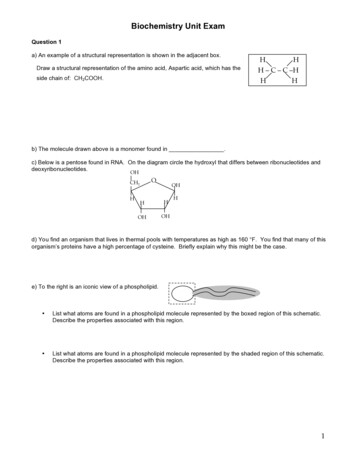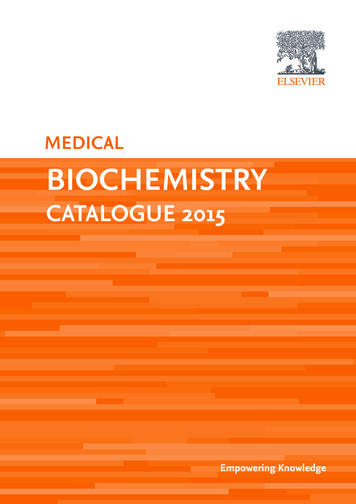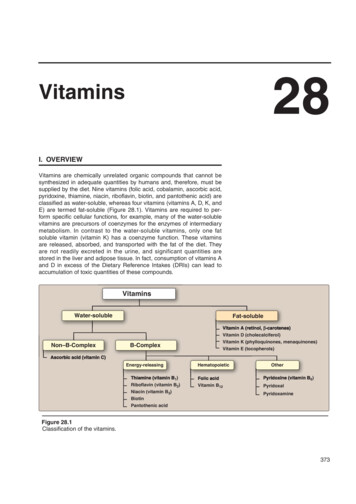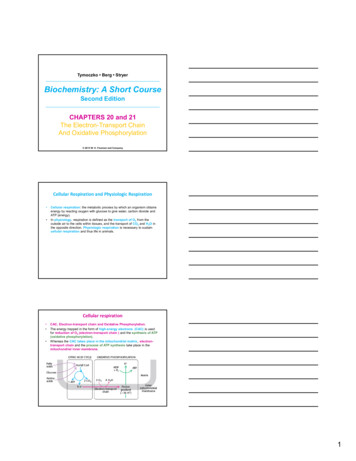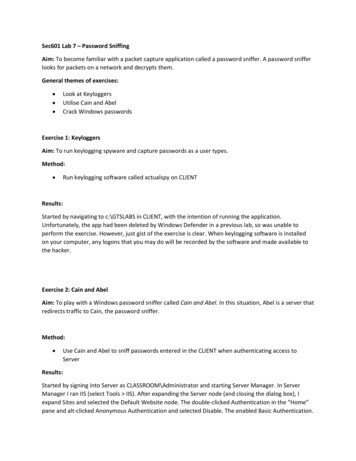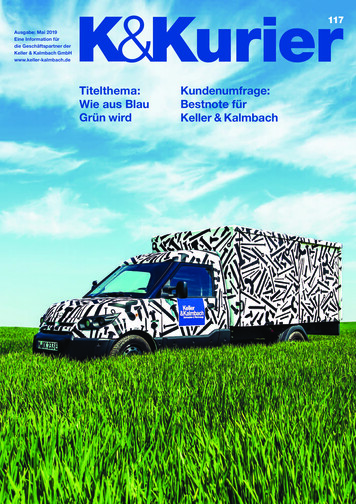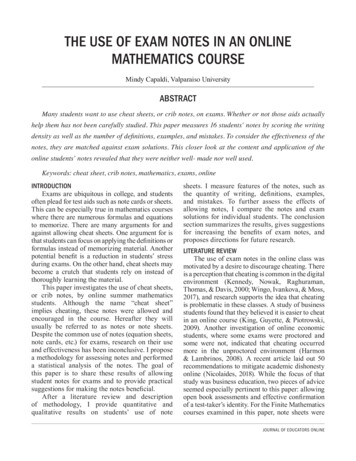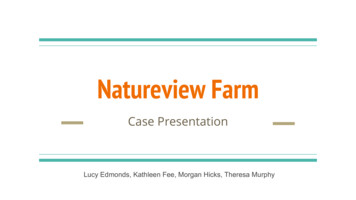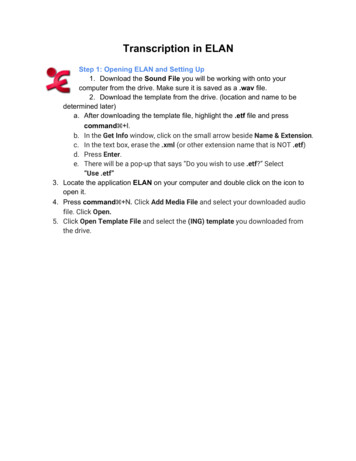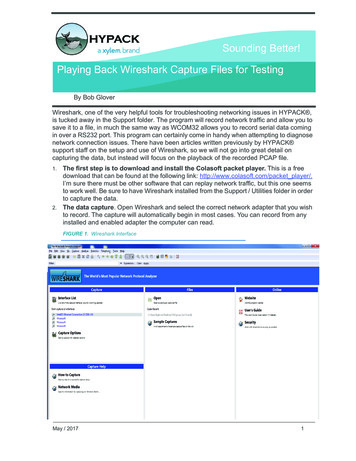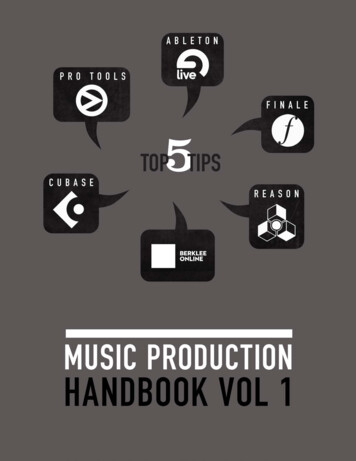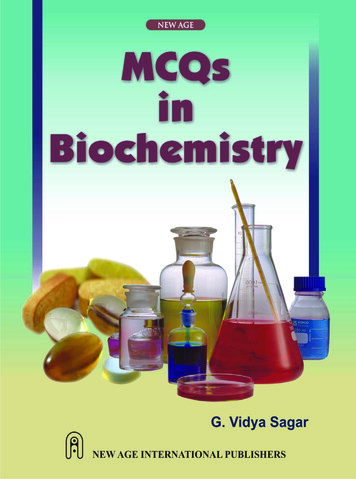
Transcription
This pageintentionally leftblank
Copyright 2008, New Age International (P) Ltd., PublishersPublished by New Age International (P) Ltd., PublishersAll rights reserved.No part of this ebook may be reproduced in any form, by photostat, microfilm,xerography, or any other means, or incorporated into any information retrievalsystem, electronic or mechanical, without the written permission of the publisher.All inquiries should be emailed to rights@newagepublishers.comISBN (13) : 978-81-224-2627-4PUBLISHING FOR ONE WORLDNEW AGE INTERNATIONAL (P) LIMITED, PUBLISHERS4835/24, Ansari Road, Daryaganj, New Delhi - 110002Visit us at www.newagepublishers.com
Dedicated toPROF. DR. F.V. MANVISecretaryKLE Society, BELGAUMKARNATAKA.“To My First Pharmacy teacher with Love”
This pageintentionally leftblank
FOREWORDCompetitive Examinations are the order of the day. All Colleges conducting professional courses at PG level areadmitting students based on common entrance examination, which is of objective type.In Pharmacy, M.Pharm admissions are based on qualifying the GATE enterance examination conducted by Govt.of India.In this book, The author has done good work in preparing several objective questions which help the students to facethe subject in the examination with poise and confidence.The book is well balanced and consists of multiple choice questions from all the important topics like carbohydratemetabolism and other important Biochemical aspects.The typesetting and quality of printing is good. The author is also well experienced in taking up this type of work.I recommend this book to all the students preparing for GATE examination and also for Medical and PharmacyCollege libraries.PROF. B.G. SHIVANANDAPrincipalAL-AMEEN COLLEGE OF PHARMACYBANGALORE.
WATER AND ELECTROLYTE BALANCE289PREFACEPREFAI have brought out this book basically for students who plan to appear for Biochemistry in the entrance examinations likeJIPMER and other Medical, Pharmacy, Physiotherapy, Nursing and other Paramedical PG Entrance Examinations. Thereis a dearth of good entrance manual of Biochemistry for the above said examinations. Hence, I have prepared anexhaustive Question bank of around 5000 MCQs with answers covering a wide spectrum of basic Biochemical topics ofthe subject.Some of the important topics which are given a good coverage include Carbohydrate metabolism, Protein metabolism, Lipid metabolism, Nucleic acids, Enzymes, Vitamins and Mineral metabolism.The objective questions are prepared based on the background taken from previous question papers of Professional medical and Paramedical competitive entrance examinations.The book serves as a ready reckoner for Biochemistry as far as objective pattern is concerned. I feel satisfied if thebook serves the purpose for which it is intended.I have tried to minimize typographical errors but still some must have crept in. If they are brought to my notice, I willbe rectifying them in the next edition.Constructive Criticism is always welcomeG. Vidya Sagar
ACKNOWLEDGEMENTSI wish to express my profound gratitude and benevolence to the following who were the inspiring force in making thisbook a reality Prof. Dr. Kishor Pramod Bhusari Sadhvi ShilapijiPrincipal, Nagpur College of PharmacyChair person, Veerayatan Vidyapeeth,Nagpur.Jakhaniya, Kutch, Gujarat Prof. Dr. R. Rangari Prof. Dr. R.K. GoyalPrincipal, J.N. Chaturvedi College of PharmacyL.M. College of PharmacyNagpurAhmedabad, Gujarat Prof. Dr. Anant Naik Nagappa Prof. Dr. A.K. SalujaPharmacy group, Birla Institute of Technology &A.R. College of PharmacySciencesVallabh VidyanagarPilani, RajasthanGujarat Prof. Dr. Srinivas Rao Prof. J.V.L.N. Sheshagiri RaoPrincipal, VEL’s College of PharmacyDept. of Pharmaceutical SciencesChennaiAndhra University, Vishakhapatnam, A.P.Finally, I express my gratitude to Mr. Saumya Gupta. MD, New Age International (P) Limited, New Delhi, for hisencouragement and support.Dr. G.Vidya Sagar
SOME VALUABLE COMMENTSVALUALUABLEThis book is very useful for students appearing for GATE Exams. Recommended reading.Prof. Dr. Subhas C. MarihalPrincipal, Goa College of Pharmacy, Goa.Biochemistry made simple in the form of multiple choice questions. Strongly recommended.Prof. Dr. Vijaykumar Ishwar HukkeriPrincipal, KLE College of Pharmacy, HubliDr. Vidya Sagar can be applauded for his untiring efforts in bringing out such a good book.Recommended for students and LibraryDr. G. Devala RaoPrincipal, Sidhartha College of Pharmaceutical SciencesVijaywada, A.P.This book will be very useful companion for students appearing for PG Medical, Pharmacy, Nursing andPhysiotherapy competitive exams.Prof. Dr. T.K. RaviPrincipal, Sri Ramakrishna Institute of Pharmaceutical ScienceCoimbatore.MCQs are well framed, mostly from previous entrance examinations. Commendable work.Prof. Madhukar R. TajneDeptt. of Pharmaceutical Sciences,Nagpur University, Nagpur
CONTENTSPrefaceChapter 1INTRODUCTION TO BIOCHEMISTRYTOCHAPTER 2CARBOHYDRATES AND CARBOHYDRATE ER 3PROTEINS & PROTEIN METABOLISMPROTEINSPROTEINMETABOLISMCHAPTER 4FATS & FATTY ACID METABOLISMFAACIDMETABOLISMCHAPTER 5VITAMINSVITAMINSCHAPTER 6ENZYMESCHAPTER 7MINERAL METABOLISMMETABOLISMCHAPTER 8HORMONE METABOLISMMETABOLISMCHAPTER 9NUCLEIC ACIDSACIDSCHAPTER 10WATER & ELECTROLYTE BALANCEELECTROLYTE(x)152775113141183209237281
This pageintentionally leftblank
CHAPTER 1INTRODUCTION TOBIOCHEMISTRY1. A drug which prevents uric acid synthesisby inhibiting the enzyme xanthineoxidase is(A) Aspirin(C) Colchicine(B) Allopurinol(D) Probenecid2. Which of the following is required forcrystallization and storage of thehormone insulin?(A) Mn (C) Ca (B) Mg (D) Zn 3. Oxidation of which substance in the bodyyields the most calories(A) Glucose(C) Protein(B) Glycogen(D) Lipids4. Milk is deficient in which vitamins?(A) Vitamin C(C) Vitamin B2(B) Vitamin A(D) Vitamin K5. Milk is deficient of which mineral?(A) Phosphorus(C) Iron(B) Sodium(D) Potassium6. Synthesis of prostaglandinsis is inhibitedby(A) Aspirin(C) Fluoride(B) Arsenic(D) Cyanide7. HDL is synthesized and secreted from(A) Pancreas(C) Kidney(B) Liver(D) Muscle8. Which are the cholesterol esters that entercells through the receptor-mediatedendocytosis of lipoproteins hydrolyzed?(A)(B)(C)(D)Endoplasmin reticulumLysosomesPlasma membrane receptorMitochondria9. Which of the following phospholipids islocalized to a greater extent in the outerleaflet of the membrane lipid bilayer?(A)(B)(C)(D)Choline phosphoglyceridesEthanolamine phosphoglyceridesInositol phosphoglyceridesSerine phosphoglycerides10. All the following processes occur rapidlyin the membrane lipid bilayer except(A)(B)(C)(D)Flexing of fatty acyl chainsLateral diffusion of phospholipidsTransbilayer diffusion of phopholipidsRotation of phospholipids around their longaxes11. Which of the following statement iscorrect about membrane cholesterol?(A) The hydroxyl group is located near the centreof the lipid layer(B) Most of the cholesterol is in the form of acholesterol ester(C) The steroid nucleus form forms a rigid, planarstructure
2MCQs IN BIOCHEMISTRY(D) The hydrocarbon chain of cholesterol projectsinto the extracellular fluid12. Which one is the heaviest particulatecomponent of the cell?(A) Nucleus(C) Cytoplasm(B) Mitochondria(D) Golgi apparatus13. Which one is the largest particulate of i apparatusEntoplasmic reticulum14. The degradative Processess are categorizedunder the heading of(A) Anabolism(C) Metabolism(B) Catabolism(D) None of the above15. The exchange of material takes place(A)(B)(C)(D)Only by diffusionOnly by active transportOnly by pinocytosisAll of these16. The average pH of Urine is(A) 7.0(C) 8.0(B) 6.0(D) 0.017. The pH of blood is 7.4 when the ratiobetween H2CO3 and NaHCO3 is(A) 1 : 10(C) 1 : 25(B) 1 : 20(C) 1 : 3018. The phenomenon of osmosis is oppositeto that of(A) Diffusion(C) Affusion(B) Effusion(D) Coagulation19. The surface tension in intestinal lumenbetween fat droplets and aqueousmedium is decreased by(A) Bile Salts(C) Conc. H2SO4(B) Bile acids(D) Acetic acid20. Which of the following is located in themitochondria?(A) Cytochrome oxidase(B) Succinate dehydrogenase(C) Dihydrolipoyl dehydrogenase(C) All of these21. The most active site of protein synthesisis the(A) Nucleus(C) Mitochondrion(B) Ribosome(D) Cell sap22. The fatty acids can be transported intoand out of mitochondria through(A) Active transport(B) Facilitated transfer(C) Non-facilitated transfer(D) None of these23. Mitochondrial DNA is(A)(B)(C)(D)Circular double strandedCircular single strandedLinear double helixNone of these24. The absorption of intact protein from thegut in the foetal and newborn animalstakes place by(A) Pinocytosis(C) Simple diffusion(B) Passive diffusion(D) Active transport25. The cellular organelles called “suicidebags” are(A) Lysosomes(C) Nucleolus(B) Ribosomes(D) Golgi’s bodies26. From the biological viewpoint, solutionscan be grouped into(A)(B)(C)(D)Isotonic solutionHypotonic solutionsHypertonic solutionAll of these27. Bulk transport across cell membrane isaccomplished by(A) Phagocytosis(C) Extrusion(B) Pinocytosis(D) All of these28. The ability of the cell membrane to act asa selective barrier depends upon(A)(B)(C)(D)The lipid composition of the membraneThe pores which allows small moleculesThe special mediated transport systemsAll of these
3INTRODUCTION TO BIOCHEMISTRY29. Carrier protein can(A)(B)(C)(D)Transport only one substanceTransport more than one substanceExchange one substance to anotherPerform all of these functions30. A lipid bilayer is permeable to(A) Urea(C) GlucoseSynthesizes proteinsProduces ATPProvides a pathway for transporting chemicalsForms glycoproteinsThey form cytoskeleton with microtubulesThey provide support and shapeThey form intracellular conducting channelsThey are involved in muscle cell contraction33. The following substances are cellinclusions except(A) Melanin(C) Lipids37. In mammalian cells rRNA is producedmainly in the(A)(B)(C)(D)Endoplasmic reticulumRibosomeNucleolusNucleus38. Genetic information of nuclear DNA istransmitted to the site of protein synthesisby(A) rRNA(C) tRNA(B) mRNA(D) Polysomes39. The power house of the cell is(A) Nucleus(C) Mitochondria(B) Glycogen(D) Centrosome34. Fatty acids can be transported into andout of cell membrane by(A) Active transport(C) DiffusionRibosomesEndoplasmic reticulumLysosomesInner mitochondrial membrane(A) Glycolytic enzymes(B) HMP shunt enzymes(C) Pyridine nucleotide(D) ATP32. The following points about microfilamentsare true except(A)(B)(C)(D)(A)(B)(C)(D)36. Mature erythrocytes do not contain(B) Fructose(D) Potassium31. The Golgi complex(A)(B)(C)(D)35. Enzymes catalyzing electron transportare present mainly in the(B) Facilitated transport(D) Osmosis(B) Cell membrane(D) Lysosomes40. The digestive enzymes of cellularcompounds are confined to(A) Lysosomes(C) Peroxisomes(B) Ribosomes(D) PolysomesANSWERS1. B7. B13. B19. A25. A31. D37. C2. D8. B14. B20. D26. D32. C38. D3. D9. A15. D21. B27. D33. D39. C4. A10. C16. B22. B28. D34. B40. A5. C11. C17. B23. A29. D35. D6. A12. A18. A24. A30. A36. C
This pageintentionally leftblank
CHAPTER 2CARBOHYDRATES ANDARBOHYDRATESCARBOHYDRATE METABOLISMARBOHYDRATEETABOLISM1. The general formula of monosaccharidesis(A) CnH2nOn(C) CnH2O2n(B) C2nH2On(D) CnH 2nO2n2. The general formula of polysaccharidesis(A) (C6H 10O5)n(C) (C6H 10O6)n(B) (C6 H12O5)n(D) (C6 H10O6)n3. The aldose sugar is(A) Glycerose(C) Erythrulose4.(B) Ribulose(D) Dihydoxyacetone(B) Ribose(D) Fructose5. A pentose sugar is(A) Dihydroxyacetone (B) Ribulose(C) Erythrose(D) Glucose6. The pentose sugar present mainly in theheart muscle is(A) Lyxose(C) Arabinose(B) Ribose(D) Xylose7. Polysaccharides are(A) Polymers(C) Proteins(B) Acids(D) Oils8. The number of isomers of glucose is(A) 2(C) 8(A) Epimers(C) Optical isomers(B) Anomers(D) Stereoisomers10. Isomers differing as a result of variationsin configuration of the —OH and —H oncarbon atoms 2, 3 and 4 of glucose areknown as(A) Epimers(C) Optical isomers(B) Anomers(D) Steroisomers11. The most important epimer of glucose isA triose sugar is(A) Glycerose(C) Erythrose9. Two sugars which differ from one anotheronly in configuration around a singlecarbon atom are termed(B) 4(D) 16(A) Galactose(C) Arabinose12. α-D-glucose and(B) Fructose(D) Xyloseβ -D-glucose are(A) Stereoisomers(C) Anomers(B) Epimers(D) Keto-aldo pairs13. α-D-glucose 1120 52.50 190 βD-glucose for glucose above represents(A) Optical isomerism (B) Mutarotation(C) Epimerisation(D) D and L isomerism14. Compounds having the same structuralformula but differing in spatialconfiguration are known as(A) Stereoisomers(C) Optical isomers(B) Anomers(D) Epimers
6MCQs IN BIOCHEMISTRY15. In glucose the orientation of the —H and—OH groups around the carbon atom 5adjacent to the terminal primary alcoholcarbon determines(A)(B)(C)(D)D or L seriesDextro or levorotatoryα and β anomersEpimers16. The carbohydrate of the blood groupsubstances is(A) Sucrose(C) Arabinose(B) Fucose(D) Maltose17. Erythromycin contains(A)(B)(C)(D)Dimethyl amino sugarTrimethyl amino sugarSterol and sugarGlycerol and sugar18. A sugar alcohol is(A) Mannitol(C) Xylulose(B) Pectin(D) Sucrose20. The sugar found in DNA is(A) Xylose(C) Deoxyribose(B) Ribose(D) Ribulose21. The sugar found in RNA is(A) Ribose(C) Ribulose(B) Deoxyribose(D) Erythrose22. The sugar found in milk is(A) Galactose(C) Fructose(B) Glucose(D) Lactose23. Invert sugar is(A) Lactose(B) Sucrose(C) Hydrolytic products of sucrose(D) Fructose24. Sucrose consists of(A) Glucose glucose(B) Glucose fructose25. The monosaccharide units are linked by1 4 glycosidic linkage in(A) Maltose(C) Cellulose(B) Sucrose(D) Cellobiose26. Which of the following is a non-reducingsugar?(A) Isomaltose(C) Lactose(B) Maltose(D) Trehalose27. Which of the following is a red
Biochemistry made simple in the form of multiple choice questions. Strongly recommended. Prof. Dr. Vijaykumar Ishwar Hukkeri Principal, KLE College of Pharmacy, Hubli Dr. Vidya Sagar can be applauded for his untiring efforts in bringing out such a good book. Recommended for students and Library Dr. G. Devala Rao Principal, Sidhartha College of Pharmaceutical Sciences Vijaywada, A.P. This book .
